This authentic pernil recipe creates a juicy, fall-apart-tender pork shoulder with irresistible crispy pork skin on top. Serve it the Puerto Rican way with arroz con gandules and watch how quickly it disappears!
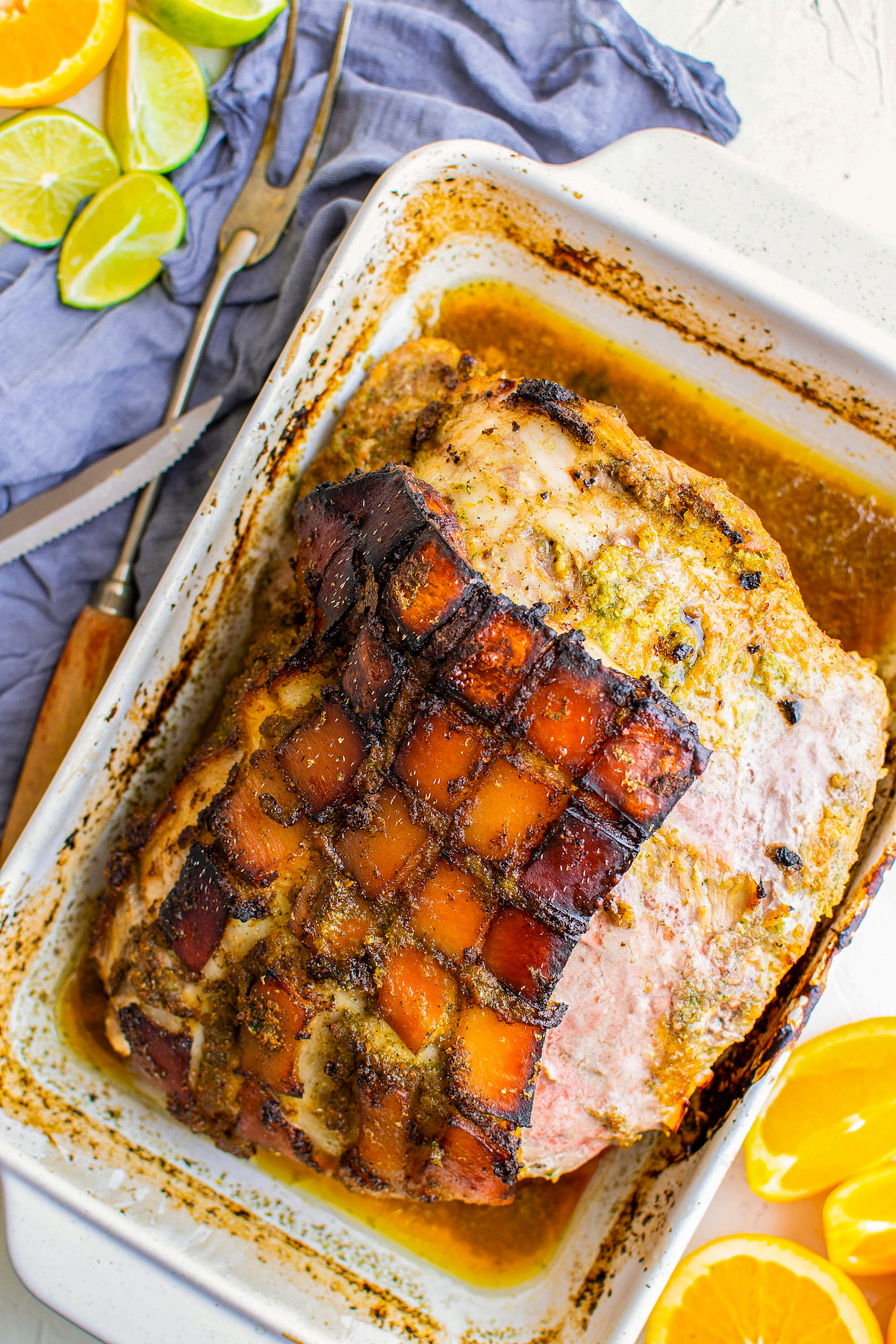
Why You Will Love This Puerto Rican Pernil Recipe
When I think of Pernil, one word comes to mind – mouthwatering. Trust me, this is a dish that will impress everyone at the table! Here’s why you will love this recipe:
- Authentic: Seasoned with garlic, sazon, fresh citrus and herbs, this is how my Abuela taught me to make pernil. With a crispy cuerito (crispy pig skin) and juicy roasted pork that is fall apart tender, you’ll be craving this dish year round!
- Festive: Seeing a roasted pernil placed onto the holiday table is a sign of love. Just like a Thanksgiving turkey, it takes a lot of prep, but it’s well worth the effort!
- Flavorful: You will never find a more tender, juicy and perfectly flavored pernil than this recipe. Trust me, this is a dish that will impress everyone at the table!
If you love roasted pork with Latin flavors, be sure to also try our recipe for lechon asado.
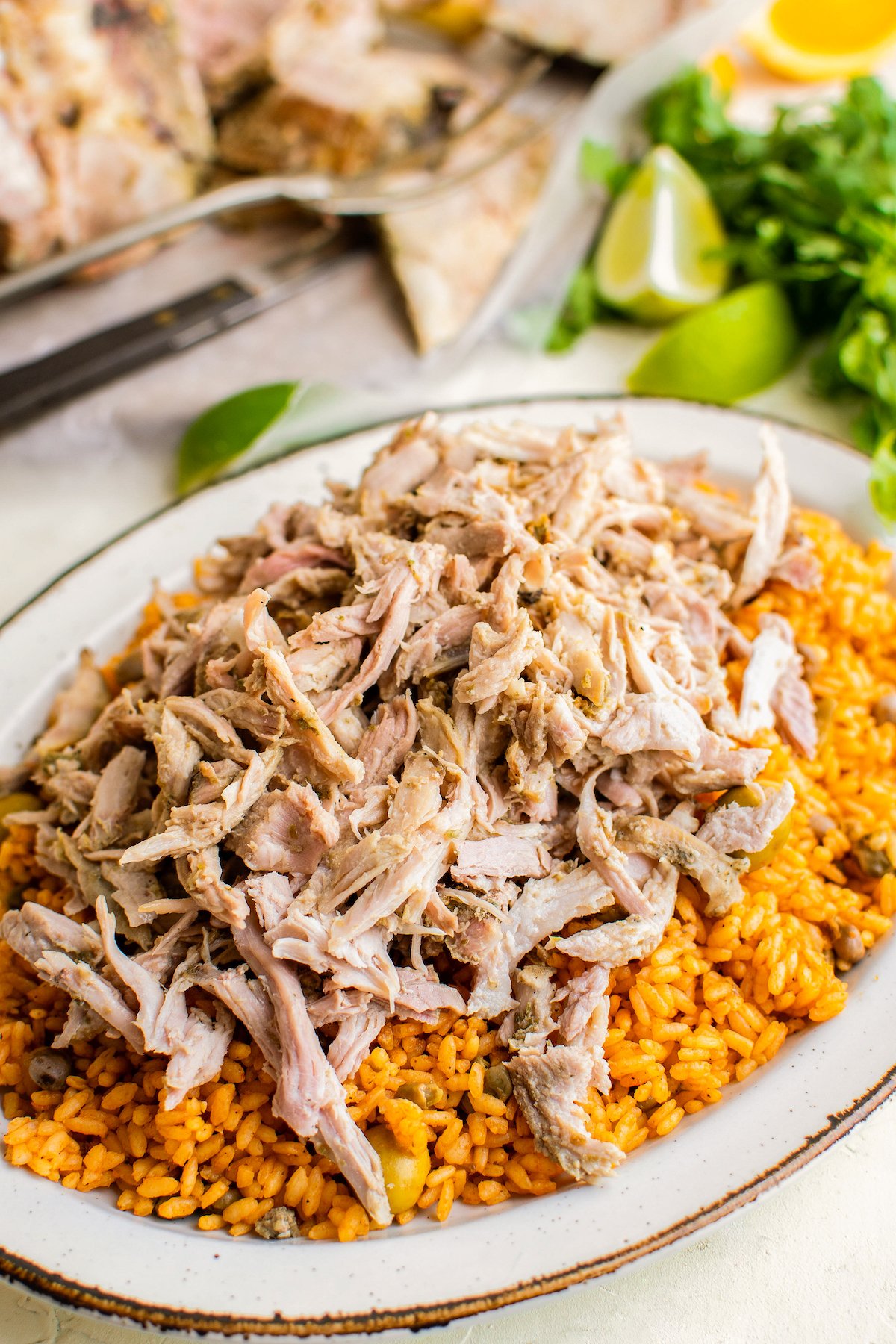
What Is Pernil?
Pernil is a slow cooked roasted pork shoulder (or leg), with crispy skin on top, that is so tender you don’t even need a knife. The pork is marinated overnight and then slow roasted as a whole piece, with the skin (fat) and the bone still intact. Puerto rican pernil is served shredded, not sliced, with arroz con gandules for special occasions.
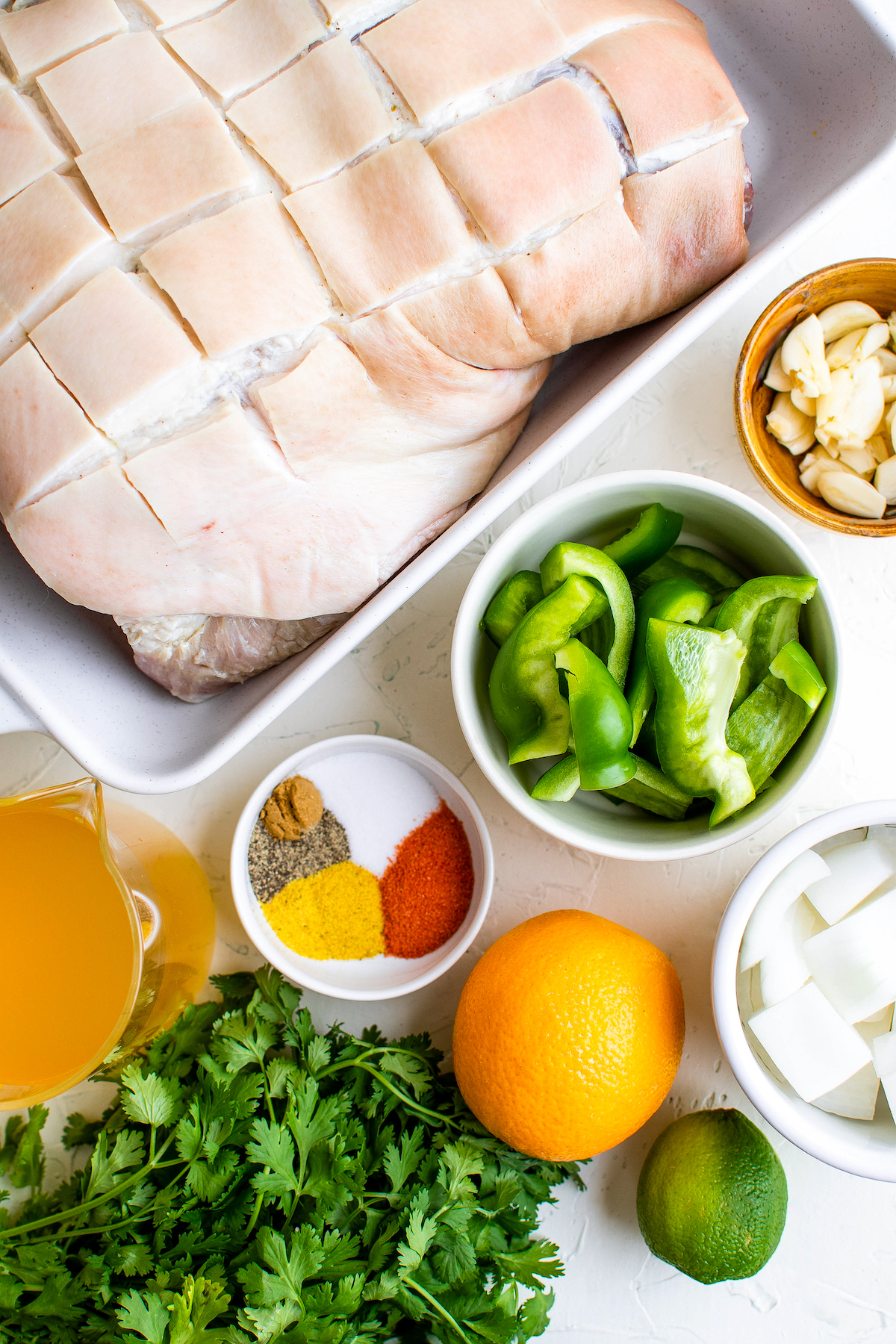
Ingredients Needed For Puerto Rican Pernil
You’ll need the following ingredients to make this flavor packed, fall apart tender Pernil. Check the recipe card at the bottom of the post for exact amounts.
- Pork Shoulder: I like to use a pork shoulder, but you can also use a pork leg roast or a pork butt.
- Garlic Cloves: You want to use lots of fresh, peeled garlic cloves.
- Oil: We used vegetable oil growing up, but you can also use olive oil.
- Green Bell Pepper: Remove the seeds and stem.
- Onion: A white onion is traditional, but a yellow onion will also work.
- Fresh Oregano: You can substitute 2 tablespoons dried oregano, but fresh is best. While not traditional, cilantro is also delicious for a different flavor.
- Seasonings: Salt, black pepper, cumin, adobo, and store bought sazon con azafrán or homemade sazon seasoning.
- Chicken Broth: I use reduced salt chicken broth because there is a lot of salt in the seasonings.
- Orange or Lime Wedges: Optional, for serving. You can also choose to add sour orange juice to the marinade.
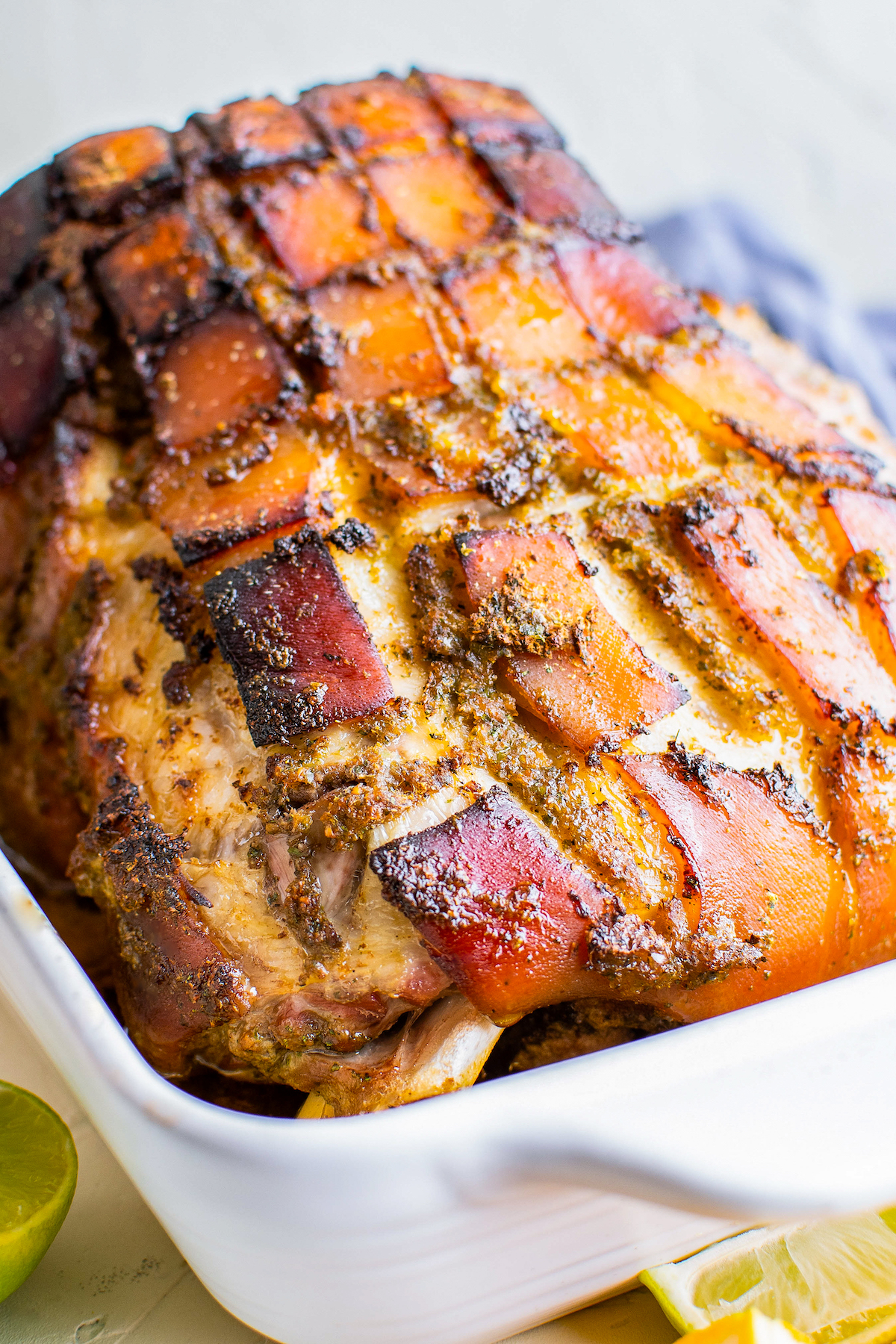
How To Make Pernil
I know it’s looks like a lot of steps, but most of the time the pork will be marinating or in the oven! Below is a quick rundown of all the steps for this Puerto Rican pork. For the full detailed directions scroll to the recipe card below.
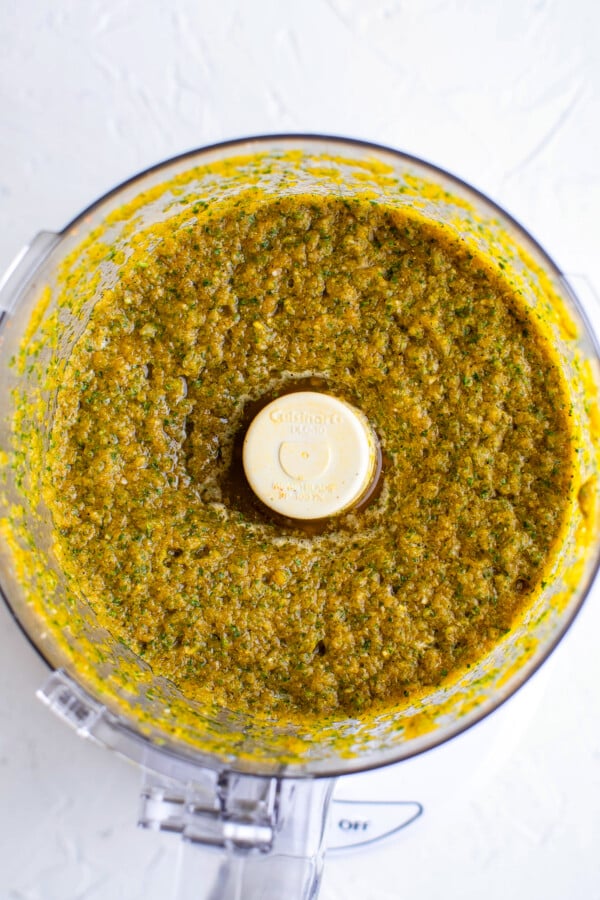
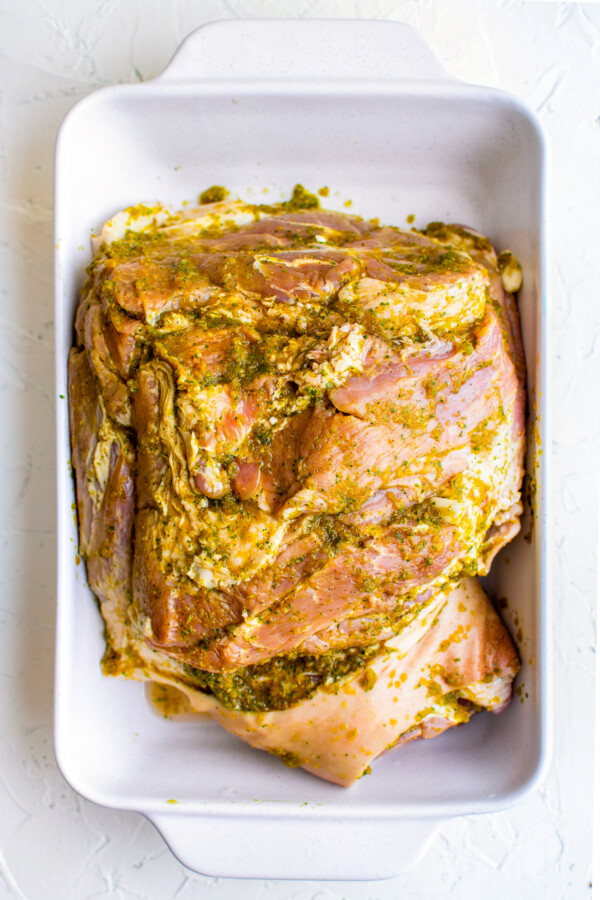
- Marinade: Combine garlic cloves, bell pepper, and cilantro in a food processor and process until smooth. Add the seasonings and process one more time.
- Garlic: Cut the fat cap from the back of the roast, still keeping it intact and attached to the meat. Fold it over so you can access the meat under it. Cut deep holes into the roast and stuff whole garlic cloves into the roast. This will give it epic flavor!
- Prep: Spoon a third of the marinade over the back of the pork. Flip and cover the top in another third of the marinade. Lay the fat cap back over the top and make deep slices to form a checkered pattern. Spread remaining marinade over the fat cap.
- Marinate: Cover the meat with aluminum foil and refrigerate for 24 to 48 hours, flipping it every so often. Do not skip this step! It’s incredibly important to ensure you get the absolute best, full flavored pernil!
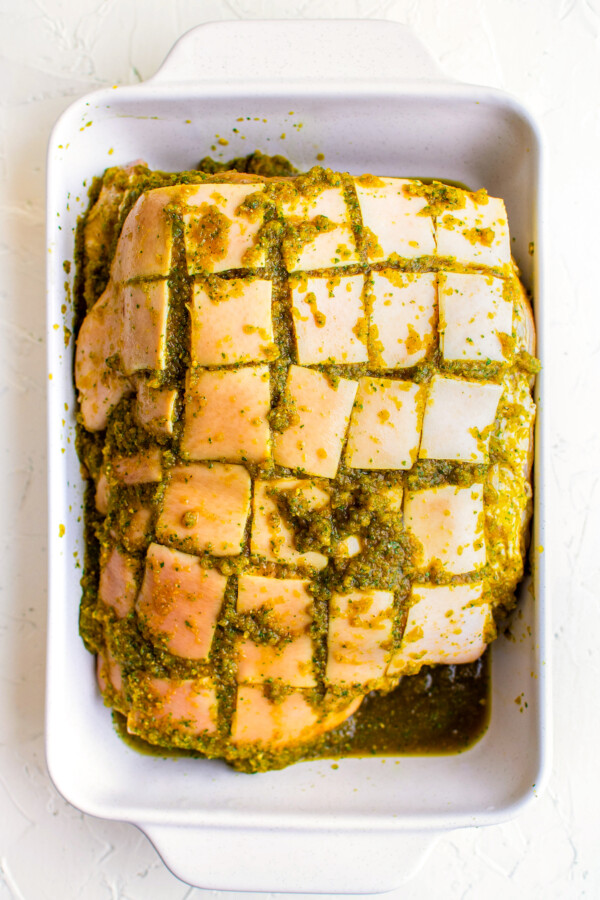
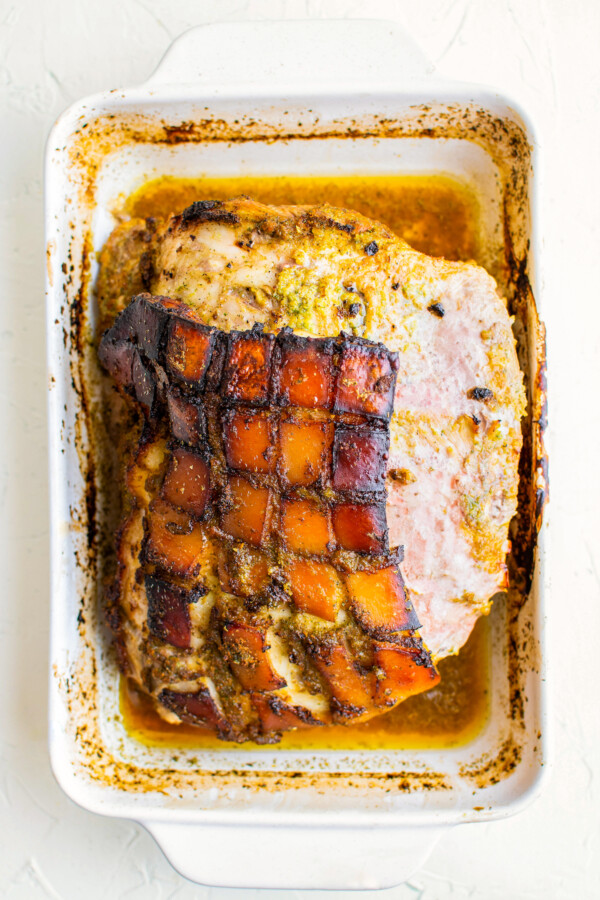
- Roast: Add pork to a roasting pan skin side up and add broth until there’s about 2 inches in bottom of the pan. Replace the foil and roast in the oven at 350°F for 3.5 to 4 hours. Rotate the pan every hour to ensure even cooking.
- Crisp: Remove the foil and turn the heat up to 400°F. Continue roasting for another 30 minutes, until the skin gets crispy on top. The internal temperature should be at least 180°F or higher.
- Knock Knock: The fun and traditional way to test of if the cuerito (crispy pig skin) is ready is by knocking on it. If it sounds like somebody is knocking at a little door, you know it’s ready!
- Rest: Before shredding, allow the meat to rest for 15 minutes minimum, or up to 30 minutes for best results. This is an important step to ensure the meat is tender and juicy.
- Shred: Shred the meat on a cutting board and pour some of the juice from the pan and the fresh orange or lime juices over the meat, if desired. Serve and enjoy!
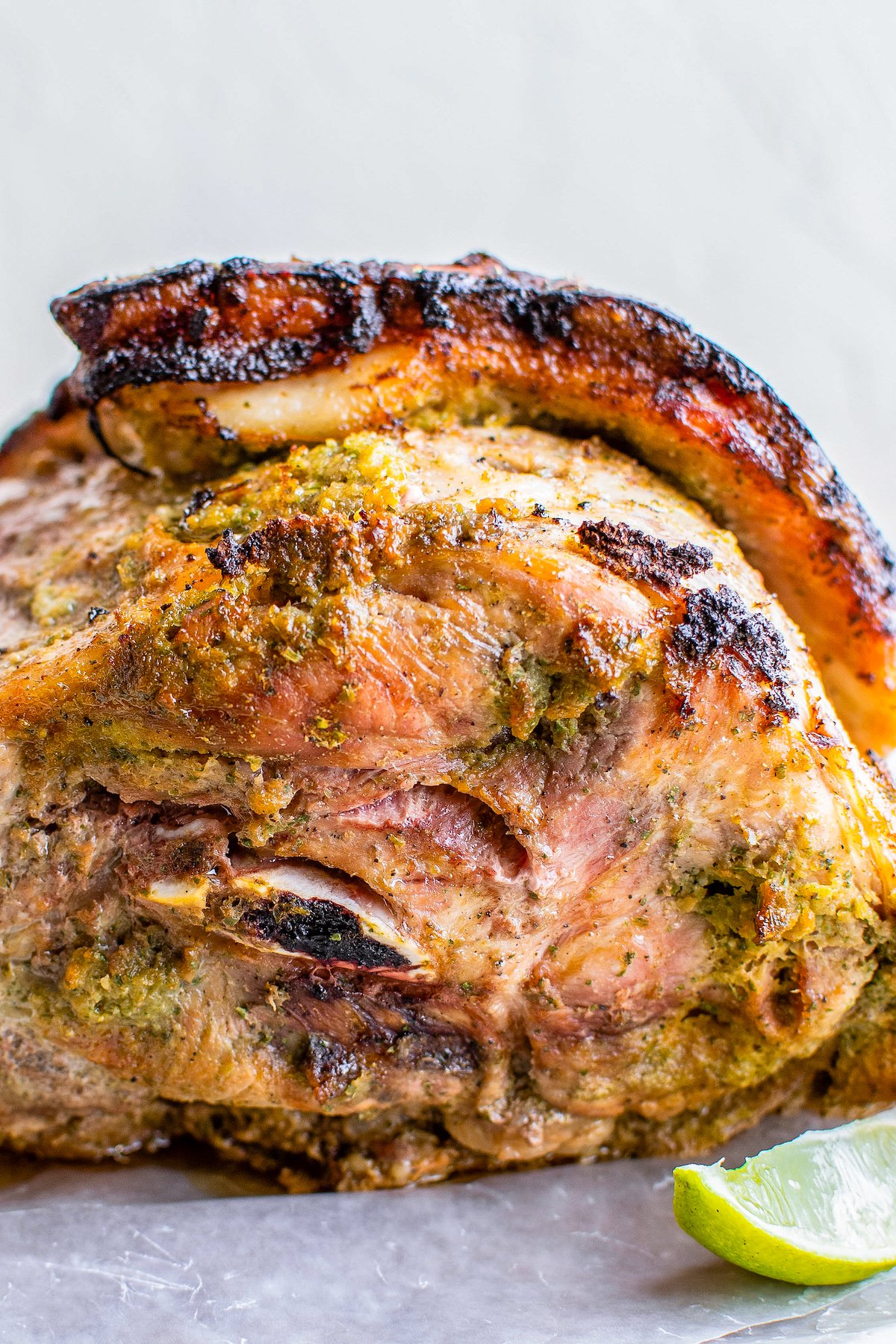
Want to save this recipe?
Tips and Variations
Here are a few tips and different variations to ensure your pernil turns out perfect:
- Pork With Fat: No matter what pork cut you choose, make sure it is bone-in, with a good amount of fat and the skin still attached. Some grocery stores in the US may call the pork shoulder a “Picnic Pork Roast” on the label, so keep that in mind.
- Plan Ahead: Make sure you plan ahead to allow plenty of time to make your pernil. If you try to rush the marinating time or cooking time, it won’t be half as good. This pernil will take about 5 hours of cooking time including cooling time after cooking.
- Marinate: It is SO very important to marinate the pork for the full amount of time. It is best if you can leave it marinading for a couple of days, but need at least 12 hours at minimum.
- Garlic: Hiding whole garlic cloves inside the pork is a traditional step that is a huge key to giving your pernil ALL THE FLAVOR. Don’t skimp or skip the garlic, you will regret it.
- Sofrito: Some Puerto Ricans use sofrito to marinade their pork. If you want to use sofrito, skip the onion and bell pepper and use 1/2 cup sofrito instead.
- Sour Orange: Want to add naranja agria, sour or bitter orange juice, to your pork marinade? Add 1/3 cup to your marinade. Fresh is best, but bottled works in a pinch.
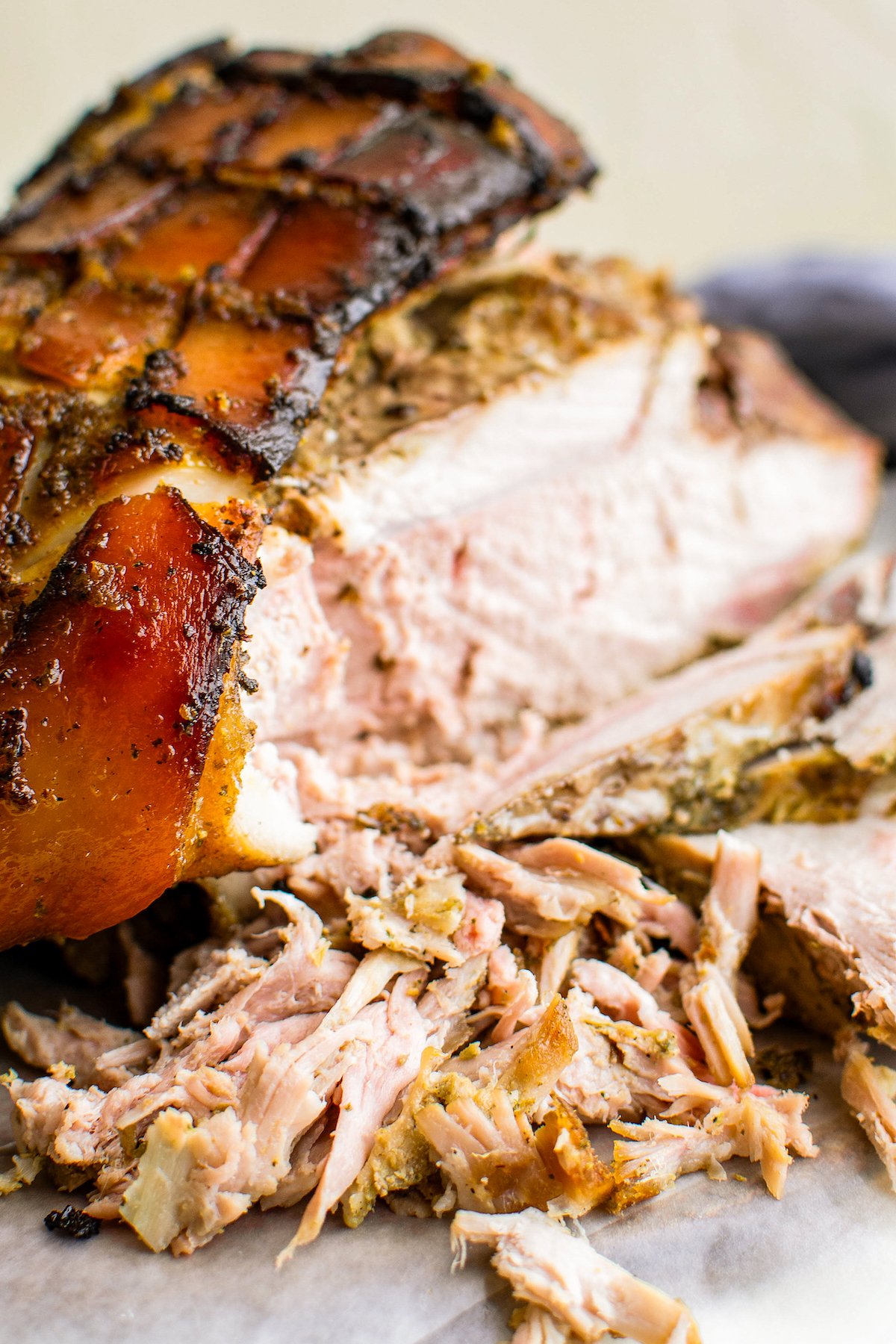
What To Serve With Arroz Con Gandules y Pernil
Of course we serve this Puerto Rican pernil recipe with arroz con gandules for the perfect Christmas dinner. Here are a few more Puerto Rican recipes to try:
- Rice And Beans: If you prefer white rice, arroz blanco and beans is always great with juicy pork.
- Plantains: Both tostones (savory fried plantains) and maduros (sweet plantains) are often served with pernil.
- Pasta Salad: Ensalada de doditos is a pasta salad served for the holidays or any large gathering. Made with hard boiled eggs and sometimes with ham (ensalada de coditos con jamon) it’s a great hearty side dish.
- Coquito: No Puerto Rican party is every complete without coquito.
- Dessert: No dinner is complete without dessert. Here are some of our favorites: arroz con leche, easy tres leche cake, tembleque and queso flan.
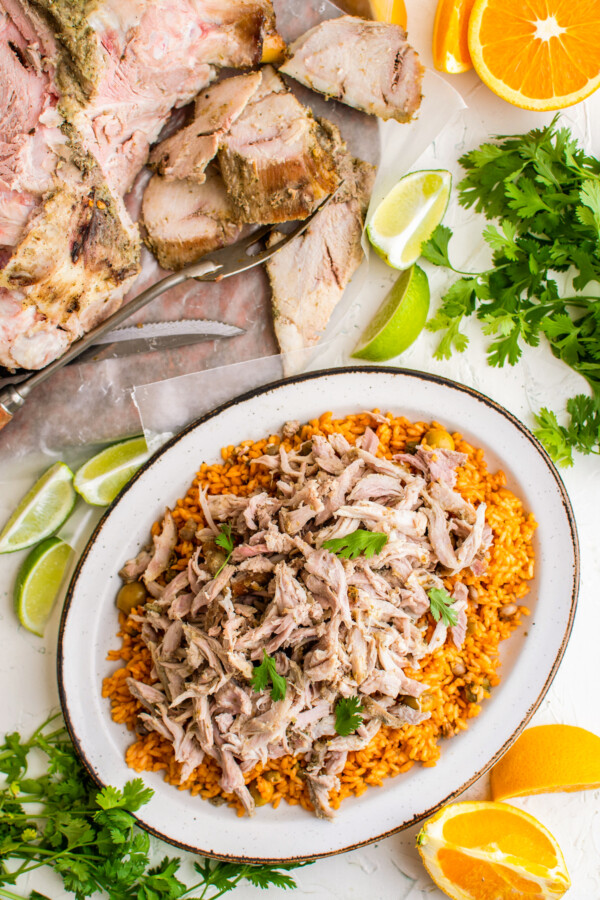
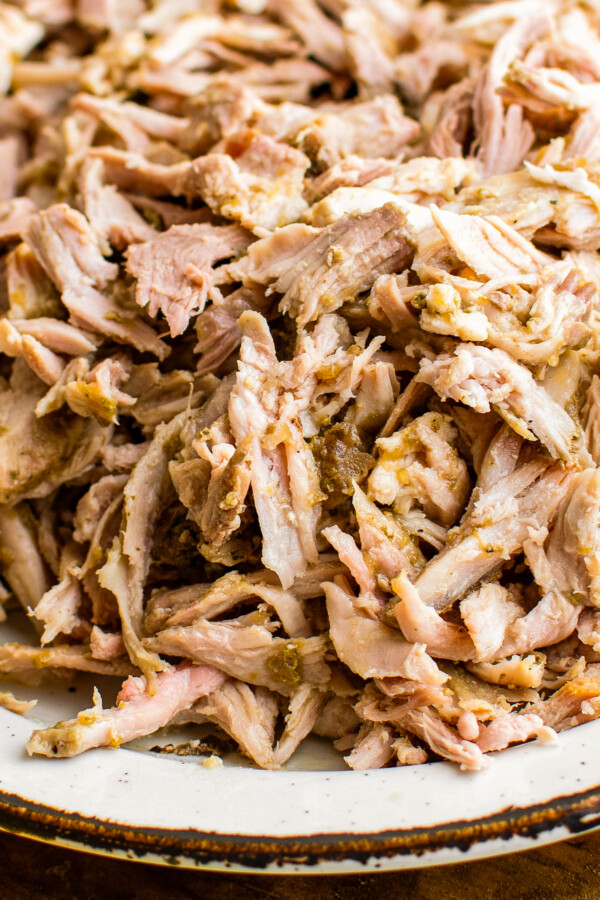
Storage Options
For a delicious breakfast the next day, serve leftovers in a mallorca with cheese!
- Fridge: Store in an airtight container for up to 5 days in the fridge.
- Freeze: Freeze cooled, shredded pork in freezer safe airtight storage bags for up to 3 months. Thaw overnight in the fridge before reheating.
- Reheat: Add meat and a couple of tablespoons of water to a bowl and cover with a wet paper towel. Heat in the microwave in 30 second bursts until warmed through. Or add meat to a large non-stick skillet with 1 to 2 tablespoons of water over low-medium heat.
Pernil Recipe
Ingredients
- 15 peeled garlic cloves, divided
- 3 tablespoons oil
- 1 green bell pepper, with the seeds removed and roughly chopped
- 1 large white onion, peeled and roughly chopped
- 1 cup fresh oregano, with large stems removed
- 2 teaspoons salt
- 1 packet sazon, or homemade sazon seasoning
- 1 teaspoon adobo powder
- 1 teaspoon ground black pepper
- ½ teaspoon ground cumin
- 8 to 10 pound pork shoulder roast, or leg roast with fat cap, cleaned and damp dry
- 3 to 4 cups chicken broth
- orange or lime wedges, for serving
Want to save this recipe?
Instructions
- Add 5 cloves of garlic, oil, bell pepper, onion, cilantro, salt, sazon, adobo powder, black pepper and cumin to a food processor or blender. Process until smooth, about 30 seconds. Set aside.
- Cut the fat cap from the back of the roast, but keep it intact and on the roast. Just fold it over so you can access the meat underneath.
- Cut deep holes into the roast, so that you can fit your finger into each hole. Flip the roast over and cut deep holes into the back as well.
- Stuff the remaining garlic cloves into the holes in the back of the roast. Then spoon a 3rd of the marinade over the back of roast and push the marinade into all of the holes as well.
- Flip the roast over and cover the top in another 3rd of the marinade, again pushing the marinade into the holes of the roast.
- Lay the fat cap back over the roast and make 4-5 deep, long, evenly spaced slices along the top of the fat, without cutting all of the way through. Then, make 4-5 more perpendicular slices to the first slices to form a checker pattern on top.
- Pour the remaining marinade over the fat cap and rub it generously into the slices of the fat cap so that every crevice is covered in the marinade.
- Marinate: Cover the pork with aluminum foil and refrigerate for 24-48 hours, flipping every 3-5 hours. This step is important to ensure you get the best flavor!
- When the roast is ready, preheat the oven to 350°F and remove the pan from the fridge.
- Lift up the aluminum foil and pour in the chicken broth or water until there is about 2 inches of liquid in the bottom of your pan.
- Replace the foil and place the roast in the oven for 3 ½ – 4 hours, rotating the pan every hour to ensure even cooking.
- Remove the aluminum foil from the pan and turn the oven heat up to 400°F. Continue roasting the pork for another 30 minutes or until the skin gets crispy on top. The internal temperature on an instant read meat thermometer should be at least 180°F or higher.
- Remove the roast from the oven and let it cool for 20-30 minutes before carving and shredding. The pork will be super crisp on the outside and tender underneath from the layer of fat.
- Once the meat has been shredded, pour some of the juice from the pan and the fresh orange juice and lime juice over the meat and stir to combine.
Notes
Video
Nutrition
Categories:
Post may contain affiliate links. Read my disclosure policy.


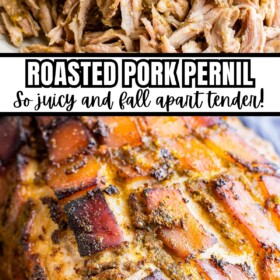

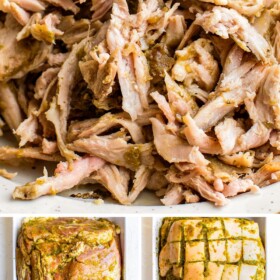
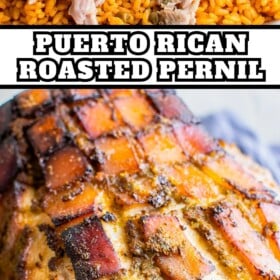
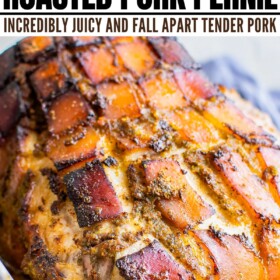

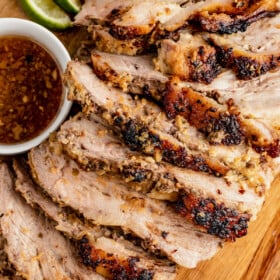
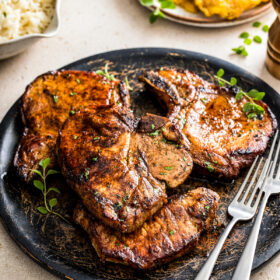

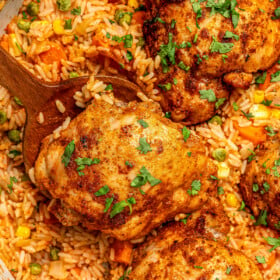
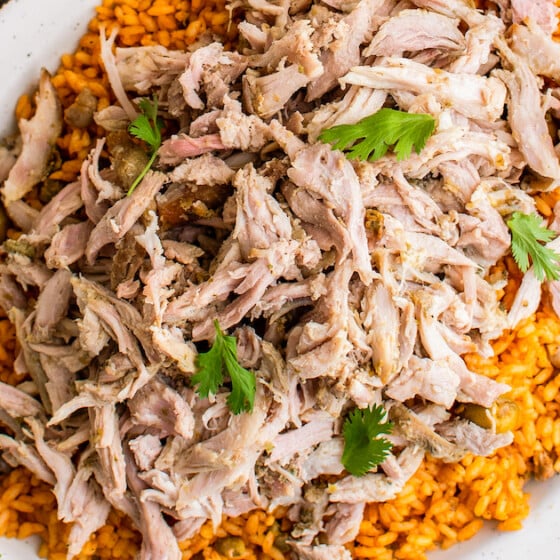

How many lbs pernil is this recipe for? It looks delicious!
Hi Cree, an 8 to 10 pound pork shoulder roast, but could be as small as 5lbs and will still work just fine!
Wow! This was beyond delicious! The result is worth the effort.
My skin didn’t crisp up so will need to try it again… I can’t wait. If you have any tips for getting the skin crispy I’d love to hear them!
Thanks for sharing!
Hands down best Pernil recipe. 3rd time making it with this recipe and most complimented.
So glad you enjoy it Nadine!
Making it again, about 9 months ago, my now husband and my younger brother loved this.
They were both so surprised how this turned out , I mainly did it because my husband is half Puerto Rican, and wanted him to explore his what would be tradition, and I half Mexican but both sides of my family – food is the center of everything. So I looveee trying different foods. ♥️
This recipe is excellent! I made this for Christmas and it was an instant hint. We agreed it took us back to Puerto Rico. Definitely worthy of 5 stars!
Tried this recipe and i can tell you my ancestors were cheering haha it was a hit and my dad is a tough credit when it comes to Puerto Rican food. My store only had boneless and it was still flavorful and moist
Hello, bone in or out?
Thank you
Hi Melissa! We use a bone in, but you can use either!
I wanna try it soon!
Honestly my roast pork is the best in the whole world really believe me went I say it yours look delicious as well OMG
If my pork is smaller (5lbs) do I reduce the time?
Yes, I would start checking your pork around the 2.5 hour mark to see if it’s cooked through and tender yet.
Is there anything else that you would serve this with? We’ve had a lot of rice lately but really want to try this! Any recommendations or recipes would be so great. Thanks!
You can serve it with any/all sides you like! You can roast veggies, serve with rice, beans, cauliflower rice if you want to go the veggie route, yuca (boiled or fried), etc etc. The options are endless! It’s a delicious pork that will go with just about any side.
I accidentally bought a fully cooked pork shoulder what do you recommend i do as far as prep and cooking instructions. Do I need to change anything at all?
Hi Audrianna! I’m sorry, but I think you should serve your pork as is. You could possibly make a sauce to add some of the flavor for Pernil, but you can not marinate or roast an already cooked pork shoulder.
I’ve tried covering with aluminum foil, however during the time in the oven the foil sticks to the fat cap and therefore to skin making it impossible to eat as the foil is stuck in tiny flakes.
I think I put too much oregano. What can I do to save it? Lol
You may spray the foil with cooking spray so foil does not stick to roast
I make a tent, so the foil is not pressed directly against the pork. You can also use non stick foil!
I made this recipe reluctantly because I have a recipe that I have been using and it’s good, but THIS? Delicious! This is the only Pernil recipe that I will be using going forward.
I made this recipe very reluctantly because I have a recipe I have been using for years and it’s good, but THIS? Delicious! The only Pernil recipe I will use going forward.
So glad you loved it Tam!!
I have been making pernil for 25+ years. I decided to try this one out and it’s the best pernil I have ever made. My husband said to throw out my old recipe jajaja 😉
Love it, I use this recipe all the time and everyone loves it…
I made this today as a trial for Christmas. This is my first time making Pernil myself – my mami usually makes it, but we can’t go see her this year because of everything going on. SO. I made it and it turned out PERFECT. Honestly, better than hers, but don’t tell her! Thank you for sharing this recipe!!